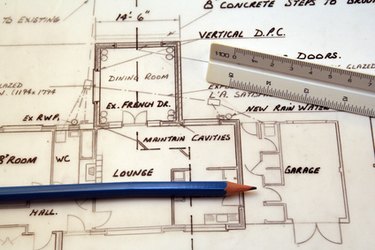
Technical drawing, also called drafting, is the drawing of graphical plans that are used to make things, especially mass-produced goods and high-precision industrial parts. According to the American Design Drafting Association (ADDA), everything manufactured today is made with a drawing. A drafter makes such a drawing based on specifications and rough sketches given to her by an engineer or other person with an idea for a new structure. Once the drafter completes a drawing for the structure, a production crew will interpret the drawing and make the structure from it. Professional drafters usually receive training in a school that's accredited by the ADDA.
Orthographic Projections
Video of the Day
One method that drafters use is orthographic projection. This is a drawing made from a viewpoint that's directly on the top, left, front, back, right, or bottom side of an object. The drawing from one of these viewpoints will show all the object's parallel lines as parallel. That sounds like common sense until you realize that human vision doesn't interpret those parallel lines this way; it instead makes them appear to converge toward each other, a phenomenon called "perspective."
Video of the Day
Pictorial Views
Orthographic views display only one side of an object at a time. By contrast, pictorial views present three sides at a time, to provide a three dimensional (3-D) illusion of the object. Different kinds of pictorial views show an object with different degrees of realism. Perspective is the most realistic, but will distort an object's parallel edges to make them converge, as described earlier.
Another type of pictorial view, oblique, shows an object's undistorted front face, but a top and left or right face that's distorted with foreshortening. (Foreshortening is the phenomenon of objects not perpendicular to your line of sight appearing shorter than they are.) Since an oblique's front view isn't distorted, you can take accurate measurements from it, unlike perspective and other views.
Traditional Tools
Most technical drawing today is done on computers. Before computers, drafting was done with manual instruments, including special drafting tables. These tables have large desktops that are slanted to directly face the drafter. Other manual instruments include rulers for drawing straight lines, and templates, compasses and French curves for drawing curves and circles.
Computer Tools
Besides being able to produce all of the graphics that manual drawing tools can, computer-based drafting tools (called computer aided design (CAD)) can automatically generate, from orthographic views, the pictorial views described earlier. This feature saves time, as drafters don't need to draw the pictorial views. Also, CAD can produce drawings that are impossible to achieve with manual drafting, including photorealistic renderings of an object. Some CAD programs also provide real-time animation functions, which enable virtual walk-arounds or flybys of an object. CAD also eliminates the potential mess that results from manually erasing part of a drawing.
Dimensioning
Dimensioning is the technical drawing technique that produces the arrows and numbers you see on a drawing. These symbols display the size and position measurements of every part of an object, which the crew that will manufacture the object needs to do their job. You can see an example of dimensioning in the top orthographic view of a design for a teapot. This view will show the hole you pour water into, and a line extending across the diameter of that hole. The line will have an arrowhead at both ends and a space in the center. In that space, the drafter will indicate the size of the hole's diameter (e.g., "3.5 inches" or "8.9 centimeters"). The complete line with its arrows and the number in the center is a dimensioning line.